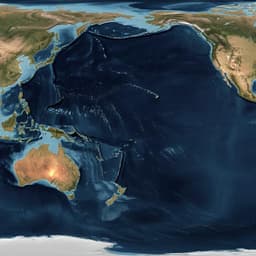
Earth Sciences
Precipitation in eastern China over the past millennium varied with large-scale climate patterns
M. Wang, C. Hu, et al.
Discover the intriguing patterns of modern precipitation variability in East China. This research, conducted by Mengyu Wang and colleagues, reveals how ancient stalagmite records unveil the interplay of solar variability and ocean dynamics over the last millennium, influencing rainfall through complex oscillations.
~3 min • Beginner • English
Introduction
The study addresses whether the meridional tripole (−/+/−) and dipole (+/−) precipitation patterns observed in modern East China persisted prior to industrial-era anthropogenic forcing and what large-scale climate mechanisms controlled them. Prior instrumental EOF analyses link these spatial structures to coupled ocean–atmosphere modes in the Pacific (ENSO, PDO) and North Atlantic (NAO, AMO) interacting with the East Asian monsoon. However, reliance on modern records leaves uncertainty about their pre-industrial behavior. Paleoclimate evidence hints that similar patterns occurred during the Medieval Climate Anomaly (MCA), Little Ice Age (LIA), the Holocene, and earlier, but a lack of continuous, high-resolution records has limited understanding of how ocean–atmosphere coupling shaped paleo-precipitation spatial patterns. Chinese speleothem δ¹⁸O records capture monsoon and local precipitation signals but are influenced by multiple processes (moisture source, upstream rainout, amount effect, evaporation). The authors propose using principal component analysis (PCA) on spatially distributed speleothem δ¹⁸O records to separate monsoon-wide and local rainfall signals and reconstruct past spatiotemporal rainfall distribution across East China over the last millennium.
Literature Review
Instrumental EOF studies show East China summer rainfall often exhibits a tripole (−/+/− across South–Central–North China) or a dipole (+/− south-to-north of the Yangtze) linked to ENSO/PDO and NAO/AMO interactions with the East Asian monsoon. Warm-phase ENSO/PDO typically yields decreased rainfall in South and North China with increased rainfall near the Yangtze (tripole). Positive NAO/AMO can favor a south-wet/north-dry dipole. Paleoclimate reconstructions and model simulations suggest similar spatial patterns occurred during the MCA, LIA, the Holocene, and deglaciation, but continuous high-resolution records to resolve spatial structure and mechanisms have been limited. Chinese speleothem δ¹⁸O records, with precise chronologies, have revealed monsoon variability from orbital to seasonal scales, yet interpreting δ¹⁸O is complex due to upstream fractionation and local amount/evaporation effects. Prior work indicates upstream monsoon intensity and local precipitation both imprint on δ¹⁸O, motivating multivariate approaches (e.g., PCA) across sites to separate shared monsoon signals from site-specific rainfall effects.
Methodology
- Study sites and records: Developed a continuous annually resolved stalagmite δ¹⁸O record from Heshang Cave (HS4), Central China, spanning 850–2000 CE. Combined with published high-resolution δ¹⁸O records from Dongge Cave (DG; DX1/DX2 composite; South China) and Wanxiang Cave (WX42B; North China). WX’s ~2.5-year resolution record was linearly interpolated to annual resolution to match DG and HS.
- Chronology and lamina counting: HS4 exhibits clear annual laminations (light–dark couplets). Year-by-year layer counting was integrated with U–Th dating to produce a precise chronology for the top 47 cm covering the last 1150 years.
- Stable isotope analysis: 1,150 annual samples were micro-milled layer-by-layer for δ¹⁸O. Measurements used a Finnigan MAT-253 IRMS with GasBench II. Results reported relative to VPDB with external error <0.20‰ (2σ).
- Data validation: HS4 annual δ¹⁸O variations were compared to nearby high-resolution speleothem records (Lianhua Cave, Xiuniu Cave), showing consistent behavior in recent centuries, supporting regional representativeness.
- Time-frequency analysis: Wavelet analyses were applied to DG, HS, and WX δ¹⁸O series to assess interannual to centennial periodicities and site-specific variability.
- Principal component analysis (PCA): Performed PCA on the three annually resolved δ¹⁸O series to separate common (monsoon) and local rainfall signals. Three PCs were extracted explaining 43.28% (PC1), 32.86% (PC2), and 24.87% (PC3) of variance. Loadings: PC1 (DG 0.69, HS 0.24, WX 0.68); PC2 (DG −0.11, HS 0.97, WX −0.22); PC3 (DG −0.71, HS 0.08, WX 0.70).
- Forcing comparisons and statistics: Compared PCs to effective solar radiation (ESR), PDO, and AMO indices. Computed decadal or 11-year averaged correlations: PC1–ESR r=0.42 (n=113, p<0.01); PC2–PDO r=0.21 (n=113, >95% confidence); PC3–AMO r=0.25 (n=113, p<0.05). Applied 20–80-year bandpass filters to assess multidecadal relationships and phase stability through time.
- Dynamical interpretation: Related PC-derived spatial patterns to shifts in the Western Pacific Subtropical High (WPSH), monsoon trough, and Meiyu front under different combinations of monsoon strength, PDO, and AMO phases.
Key Findings
- New annually resolved HS4 δ¹⁸O record (850–2000 CE) from Heshang Cave agrees with nearby stalagmite records in recent centuries, indicating robust regional signal.
- PCA separated common monsoon and spatial rainfall signals:
• PC1 (43.28% variance; loadings DG 0.69, HS 0.24, WX 0.68) reflects large-scale Asian monsoon intensity. It tracks effective solar radiation with decadal correlation r=0.42 (n=113, p<0.01). PC1 delineates MCA (strong monsoon, ~940–1340 CE), LIA (weak monsoon, ~1340–1840 CE), and CWP (strengthening monsoon, ~1840–1983 CE).
• PC2 (32.86%; loadings DG −0.11, HS 0.97, WX −0.22) represents a tripole rainfall distribution: negative PC2 implies −/+/− (dry South & North; wet Central). PC2 correlates with PDO (11-year avg) at r=0.21 (n=113, >95% confidence), with positive PDO associated with negative PC2 (tripole). Tripole structure dominated during the LIA (weak monsoon, positive PDO, negative AMO), while anti-tripole (+/−/+) occurred during MCA and CWP (stronger monsoon).
• PC3 (24.87%; loadings DG −0.71, HS 0.08, WX 0.70) captures a south–north dipole: positive PC3 indicates South-wet/North-dry; negative PC3 indicates South-dry/North-wet. PC3 correlates with AMO (11-year avg) at r=0.25 (n=113, p<0.05). During MCA, strong monsoon with negative PDO and positive AMO favored a dipole (PC3<0), while during LIA a tripole dominated (PC2<0).
- Temporal alternation of patterns: On centennial scales, precipitation patterns alternate between tripole and dipole with the coupling state of monsoon–PDO–AMO: MCA dipole dominance; LIA tripole dominance; CWP initial tripole transitioning toward dipole.
- Multidecadal variability (20–80 years): Strong monsoon phases favor negative tripole and positive dipole patterns; weak monsoon phases favor positive tripole and negative dipole. PC2–PDO and PC3–AMO phase relationships vary through time (in-phase vs anti-phase intervals), implying background-state dependence and coupled influences.
- Mechanistic link via WPSH: Weak monsoon with positive PDO and negative AMO shifts WPSH southward, enhancing Meiyu rainfall over Central China and suppressing South/North rainfall (tripole −/+/−). Strong monsoon with negative PDO and positive AMO shifts WPSH northward, yielding an anti-tripole (+/−/+); further northeastward displacement during MCA contributes to a dipole with decreased South and increased North precipitation.
- Persistence: Tripole and dipole structures and their controlling dynamics persisted over the last millennium, predating industrial-era warming.
Discussion
The findings demonstrate that modern-like meridional tripole and dipole rainfall structures existed throughout the last 1150 years and were governed by interactions among Asian monsoon strength, PDO, and AMO. By extracting a shared monsoon signal (PC1) and spatial rainfall modes (PC2 and PC3) from spatially distributed stalagmite δ¹⁸O, the study links monsoon variability to solar irradiance and attributes the tripole primarily to Pacific decadal variability (PDO) and the dipole to Atlantic multidecadal variability (AMO). The dominance of dipole during the MCA and tripole during the LIA aligns with known climatic regimes, indicating that background climate states modulate ocean–monsoon teleconnections. On multidecadal scales, unstable phase relationships between PC2–PDO and PC3–AMO suggest that no single driver controls East China rainfall patterns; rather, the coupled monsoon–PDO–AMO system, mediated by shifts in the WPSH, shapes the spatial distribution of precipitation. These insights help reconcile instrumental-era observations with paleoclimate behavior and underscore the importance of large-scale coupled modes in projecting future East Asian hydroclimate.
Conclusion
Using PCA on three high-resolution speleothem δ¹⁸O records spanning South, Central, and North China, the study isolates a common Asian monsoon signal and two spatial rainfall modes corresponding to tripole and dipole patterns. The monsoon strength (PC1) closely follows solar irradiance over the last millennium, while the tripole (PC2) is linked to PDO and the dipole (PC3) to AMO. The persistence of these structures across MCA, LIA, and CWP indicates that pre-industrial precipitation patterns in East China were governed by the same large-scale dynamics active today. Mechanistically, shifts in the WPSH under different monsoon–PDO–AMO combinations control the meridional distribution of rainfall. These results provide constraints for evaluating climate models and improving projections of future East Asian hydroclimate. Future work could expand spatial coverage with additional precisely dated, high-resolution records, integrate isotope-enabled models, and further quantify non-stationarities in teleconnections under varying background states.
Limitations
Related Publications
Explore these studies to deepen your understanding of the subject.







